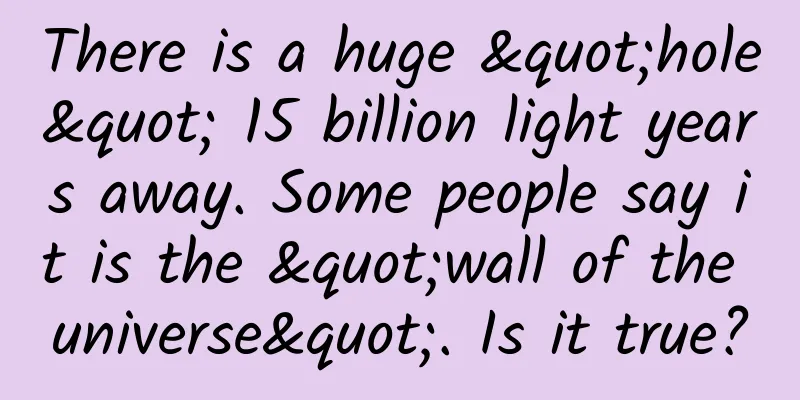There is a huge "hole" 15 billion light years away. Some people say it is the "wall of the universe". Is it true?

|
Someone discovered a huge "hole" deep in the universe 15 billion light years away in the direction of the Eridanus constellation. How big is this "hole"? 3.5 billion light years across, big enough, right? They say this is the "cosmic wall". Does the universe really have a "wall"? Why is the "wall" also a "hole"? This story begins with an article published in a magazine called New Scientist in 2018. The article was signed by an Italian astronomical institute, which looks impressive and makes people believe it. So is there really a huge wall in the universe? Let's analyze it together. Is this so-called "cosmic wall" a "hole" or a "wall"? Let me first state the conclusion: Actually, it is neither of them. It is just an area with a slightly lower temperature in the vast cosmic background. Here, it is necessary to talk about the New Scientist magazine that has caused a lot of trouble, and the "Italian astronomical institution" that published this article. Anyway, I searched the Internet and couldn't find out which institution this "certain astronomical institution" is. There are only some introductions to this magazine. It is generally said that this magazine was founded in Italy in 1956 and is a free international scientific magazine. However, this magazine is not a rigorous academic journal, but a news bulletin journal, and the articles published have never been subject to peer review. This does not mean that all articles published in this magazine are unreliable, but that the articles published in it do not require rigorous scientific verification, but only express personal opinions, so the articles are a bit mixed. Although this kind of magazine cannot be interpreted as an academic journal, it is still valuable to occasionally adjust the nerves that are tense after reading too many serious academic journals. Therefore, it can be considered that this kind of magazine is a journal between science and non-science. For example, the "cosmic wall" is just something that some people call out. There is no evidence to prove that it is the "edge of the universe". It is just a cold spot in the cosmic background radiation. However, some people who say it unintentionally may take it seriously, and some people who like to spread rumors and conspiracy theorists have used it to create many strange legends. Therefore, to be precise, the so-called "cosmic wall" is neither a "hole" nor a "wall", but just a "cold spot" in the cosmic background radiation. Why are there "cold spots" in the universe? In fact, this is not surprising. In our world, there is no completely uniform matter. A person, a blade of grass, or a speck of dust may seem smooth and perfect, but when viewed under a high-power microscope, you will see many holes, fibers, cells, and even DNA. This is even more true for the vast universe. The energy from the Big Bang 13.8 billion years ago has continuously cooled and expanded to become today's countless stars and galaxies, forming an observable universe with a diameter of 93 billion light years. The Planck temperature of the universe at the moment of the Big Bang was about 1.4*10^32K. After 13.8 billion years of cooling, the remaining temperature is only 2.73K (minus 270.42℃), which is the so-called 3K background radiation of the universe. However, the expansion of the universe cannot be completely uniform. The density of matter is higher in some places and less in others. The background temperature of the entire universe is also in a relatively uniform state, with some imbalances, with some places being slightly higher and some places being slightly lower. Scientists have conducted a comprehensive detection and scan of the cosmic background using various satellites and telescopes, using electromagnetic waves of various bands, and obtained an accurate cosmic microwave background radiation map (see the figure above). The dark blue areas in the figure are the so-called "cold spots". The temperature of these "cold spots" is lower. How much lower? In fact, it is not much, just 7 parts per 100,000 lower than the average temperature! As you can see in the picture, there are many cold spots, but only a few are huge. The so-called "cosmic wall" is just a larger "cold spot". This mysterious call has aroused the farce of people who always want to do something. That's all. "Cold spots" are dark areas that are common in the universe. The report about the "cold spot" was published as early as 2004. It was discovered by astronomers from Purdue University in the United States. It is also located in the constellation Eridanus, about 6 billion light-years away from us. The span of this "cold spot" is about 1 billion light-years. It's just that the 3.5 billion light-year "cold spot" mentioned by New Scientist magazine is larger in scale. Modern astronomical research believes that dark matter and dark energy dominate the formation of galaxies and the expansion of the universe. The structure of the universe is pulled by dark matter, while dark energy drives the expansion of the universe. The fate of the universe in the future depends on the game between these two forces. Different outcomes determine different outcomes of the universe. From a large scale perspective, the current universe is an intricate mesh structure, a bit like a loofah (see the picture above). Those bright lines in the mesh are densely packed galaxy matter pulled by dark matter, and the dark areas in the middle of these networks are the so-called "cold spots." These places are not very "cold", nor are they completely empty; they are just slightly cooler and have fewer galaxies. An alternative legend about "cold spots". There is no basis for calling the "cold spots" in the cosmic structure "cosmic walls" and saying that they are the boundaries of the universe. The mainstream scientific community believes that the radius of the observable universe is 465 light years. Based on the Big Bang process and the expansion rate, there are two unobservable ranges in the universe. Therefore, there is an immeasurable unobservable universe outside the observable universe. It is impossible to determine how big the universe is. So where does this "cosmic wall" 13 billion light years away from us come from? Is it because of this so-called "cold spot" that the universe has shrunk so much? Even if we imagine that there is such a hole, it cannot be called a wall. It is more like a "hole in the wall" that has been broken. You know what, there really is a saying similar to "hole in the wall". There is a theory that this "cold spot" is evidence of a multiverse or parallel universe, a universe that exists outside of our universe, and a trace of a collision between the external universe and our own universe. Could it really be a "hole in the wall" that has been broken? This theory is even more absurd. There is no evidence to prove the existence of an external universe, nor is there any evidence that this is really a trace of collision. Because there is such a "trace", it is believed that there is an external universe; conversely, it is believed that there is an external universe, and this is a trace of collision. This kind of logic of mutually proving conclusions and arguments is called circular reasoning, just like two criminals who committed a crime together proving that the other party did not have time to commit the crime. This is extremely absurd. Science requires empirical evidence or rigorous mathematical and logical arguments, not imagination. That’s it, welcome to discuss, thanks for reading. Original copyright of Spacetime Communication |
<<: Sleep vs. Health——To the Working People!
>>: My knees make a "cracking" sound when I squat. Is there something wrong with my joints?
Recommend
In-depth analysis: How to operate 2B products
A large number of companies and products have bee...
We are fighting a tough battle with the "alien biological army"...
Fifty years ago, in 1972, the United Nations held...
What are the ways to make money with APP?
App developers often ask themselves a question: h...
2018 Baidu Smart Mini Program Open Course Starts! Hundreds of Billions of Traffic Benefit Developers
On December 13, 2018, Baidu Smart Mini Program Op...
Dos and Don'ts of Writing Android Unit Tests
[[183206]] In this article, I will explain the be...
SEO 100,000 Whys? What is SEO?
Here, we have collected common SEO problems and c...
10 strategic indicators on how to quickly increase the volume of advertising!
This article will introduce in detail the specifi...
What exactly is the user growth concept that has reaped the benefits of countless exploits?
The most important part of user operation is user...
Three strategies for long-term success of popular brands
After creating a category, you must dominate the ...
How much is the price for being an agent of Shiyan Toy Mini Program? Shiyan Toys Mini Program Agent Price Inquiry
How much does it cost to be an agent of a toy min...
Well logging: the “smart eye” in coalbed methane exploration and development
The exploration and development of coalbed methan...
Share 4 niche but conscientious APPs: Each one is one in a hundred, please use it in a low-key manner
In our lives, almost everyone has a mobile phone....
Roewe Ei5 released: the world's first pure electric Internet travel car debuts at the Guangzhou Auto Show
In recent times, the SAIC Roewe brand, which has ...
In-depth | Has the consumer revolution arrived? Takeaway recyclable tableware is becoming a trend in the United States
"Am I the only one who is concerned about th...
Detailed tutorial on Tik Tok operation, algorithm interpretation, platform rules...
Tik Tok has all the motivations to be addictive. ...









